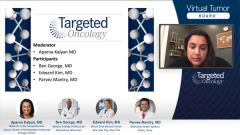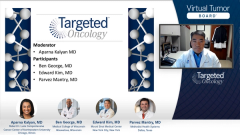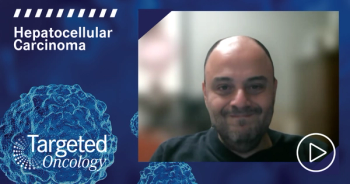
Case 3: A Patient With Metastatic HCC
After introducing the third case, a patient with metastatic hepatocellular carcinoma, experts share their perspectives on the optimal diagnosis and work-up of advanced disease.
Episodes in this series

Transcript:
Aparna Kalyan, MD:We’re going to look at the next case now. Which is a good bridge from this point.
Ben George, MD:It looks like a case of metastatic hepatocellular carcinoma [HCC]. This is a 60-year-old man who presented with abdominal pain and shortness of breath. On exam, the patient is obese, with a BMI [body mass index] of 31 but has no heart failure or diabetes. He has hypertension that’s controlled on an ACE inhibitor. He has no history of hepatitis C or B. He had a minor surgery 5 years ago. He’s married, and he works as a plumber with his own business. He has light alcohol—less than 3 drinks per week. He’s a former smoker, 25 pack-years, but he quit 3 years ago.
On work-up, the primary care doctor ordered an MRI. It demonstrated 3 tumors in the right lobe of the liver, each approximately 3 cm, and 2 spots in the right lung, lower lobe. He has an alpha-fetoprotein [AFP] level of 490 ng/mL. His hepatitis panel is negative. His bilirubin level is 2.2 mg/dL. ALT, AST, alkaline phosphatase are all minimally elevated. His INR [international normalized ratio] is 1.4. CBC [complete blood count] and platelets are normal. He has a mildly compromised kidney function, an eGFR [estimated glomerular filtration rate] of 75 mL/min. He is BCLC [Barcelona Clinic Liver Cancer] C, Child-Pugh A, with an ECOG performance status of 0.
Aparna Kalyan, MD: Is there anything additional that you’d need in this patient before we talk about next steps of how we would approach him? Dr Mantry, is there anything else that you’d need, or want to know, before we decide on a treatment plan?
Parvez Mantry, MD:That’s a good question. I think not. The diagnosis in my mind is pretty clear. As I mentioned to you earlier, hepatocellular carcinoma is, 95% to 98% of the time, a radiological diagnosis. When you combine it with biochemical parameters like AFP, you don’t need tissue. The other thing is that doing tissue diagnosis on these patients, although it may give us additional information, is also fraught with visceral bleeding because of a vascular tumor and implantation metastases. It’s a moot point in this patient because he already has metastatic disease. But the diagnosis is clear, and we’re ready to move on to treatment without additional testing.
Aparna Kalyan, MD:Dr Kim, at some of the academic institutions, we talk about getting biopsies on these patients, even though we know that the diagnosis is. What are some of the risks that we should worry about when we try to get a biopsy, whether it’s at the time of an angiogram or doing a Y90 procedure, or chemoembolization?
Edward Kim, MD:We’re assuming that he has notch cirrhosis. He needs to be worked up as such. I haven’t disagreed at all yet, but I’ll disagree in this case because the patient doesn’t have underlying hepatitis C or hepatitis B ideology. I don’t know what the scan looks like, whether it shows cirrhosis on the liver, or portal hypertension. But in the absence of that, I understand he’s obese. I do think we need a biopsy in this situation to assess whether it truly is HCC. I get if the alpha-fetoprotein is high, but there’s no underlying ideology here, from my understanding.
Parvez Mantry, MD:That’s a great point. I live in Texas, which has the highest prevalence of—and the highest mortality from—liver cancer in the country. Based on a study, the reason is obesity. Because Texas, Louisiana, Arkansas, and Alabama have the highest prevalence for liver cancer in the country, and the underlying phenomenon is obesity. Therefore, because we’re treating a lot of hepatitis C and getting it cured, NASH [nonalcoholic stereohepatitis] is the pandemic of the century because causes the most liver cancer in our country. As you pointed out, it’s very under recognized. I get this question a lot form medical oncologists, interventional radiologists, and even gastroenterologists. If the AFP is greater than 400 ng/mL, unless you have a mediastinal tumor, or a scrotal tumor—male—in the setting of liver disease, it’s about 90% specific for HCC.
Aparna Kalyan, MD:My question was more the practical concerns or adverse effects that you see. From a medical oncology perspective, it’s easy for me to call you and say, “I need some tissue for additional testing.” But I never fully understand the practical implication of it. Does it change how you do your Y90? Does that increase your risk of aneurysm? Does it change any of those things?
Edward Kim, MD:In terms of the practical use of our biopsies, it depends on size and location of the biopsy, whether we can see it on ultrasound or a CT. Or we must fuse different modalities together to see the lesions. A lot of people worry about hemorrhage and potential seeding in that type of situation. With very good techniques, that’s quite minimized in terms of bleeding complications, but it’s there. As we all know, it’s a very hypervascular lesion. In terms of it affecting our transarterial therapies, I don’t think it’s enough to deter us from getting a biopsy if it’s needed. Whether in a trial or outside a trial, in worrying about the potential consequence of a fistula or an aneurysm that can occur, IR [interventional radiology] is savvy. We should be able to navigate around those things to treat patients. I don’t concern myself with those. Sometimes we do obtain biopsy at the time. For instance, a mapping procedure. We haven’t seen any issues with that.
Transcript edited for clarity.













































